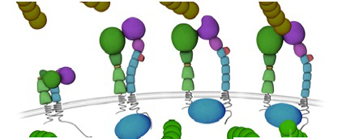Cell to cell adhesion (integrins)
Cell to cell adhesion  between live Dictyostelium cells was measured in a collaboration with Gerisch's group at the MPI Martinsried. Controlling the interaction force, and by means of this the size of the interacting membrane areas between the two cells, and by allowing minimized time for this cellular interaction, we were able to measure the adhesion forces between the cells down to the level of individual cell adhesion molecules (in particular integrins).
between live Dictyostelium cells was measured in a collaboration with Gerisch's group at the MPI Martinsried. Controlling the interaction force, and by means of this the size of the interacting membrane areas between the two cells, and by allowing minimized time for this cellular interaction, we were able to measure the adhesion forces between the cells down to the level of individual cell adhesion molecules (in particular integrins).
 Different integrin conformations interacting with intra- and extracellular proteins
Different integrin conformations interacting with intra- and extracellular proteins
(modified image from R. Fässler)
By genetic engineering the cell adhesion proteins and their regulation were altered and the resulting changes in adhesion forces were investigated. The future of this kind of experiments lies in the development of functional genomic assays based on transient or permanent transfection.
Cell adhesion is fundamental for locomotion, for food uptake of individual cells and for arranging multicellular organisms. Cell adhesion plays crucial roles in navigation of immune cells, regulating the bloodstream (thrombosis/clotting) and became subject in medical, pharmaceutical and therefore basic research.
research funding:![]()



![]()
Integrin adhesion: SFB863,
Immune system: SFB914,
Blood clotting: SHENC,
Bone marrow metastatis: Ministry of education, Turkey,
Dentin adhesion: Ministry of education, Turkey, NIM,

